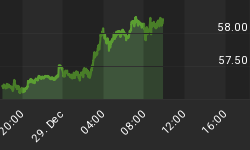Why have gold prices been weak despite rising treasury yields, and is the gold weakness just a temporary setback or something more? But first, we would like to examine why yields are on the upswing. The main reasons are clear:
-
Central Banks in much of the world are reacting to a threat of inflation by pushing short term interest rates up. As the world economy remains robust, the long term interest rates are following. Even though the Federal Reserve in the U.S. is not raising rates, higher interest rates around the world are spilling over into the United States.
-
Possibly the more important factor is that the world's currency reserves of around $5 trillion are being slowly reallocated away from the dollar. We know that China, Russia, and a score of oil exporters have expressed their intentions to reduce U.S. dollar exposure, and some have already done so.
Although bond prices have thus far moved substantially lower, they are still heftily priced. A persistent but orderly downtrend would be reasonable and far from cataclysmic.
Yet, it is not inconceivable that the central bankers may start to panic as they see the value of their vast U.S. bond holdings shrink rapidly. In this case, emotions could take over and bonds will fall faster and further than anyone anticipates. We don't believe that this scenario is likely at this point in time, yet it cannot be ruled out in the future.

In the chart above, the ratio between the U.S. dollar and the 10-Year T-Note yield is one of the best indirect indicators for capital inflow into the United States. A consistent downward trend since 2003 shows that despite rising interest rates, the U.S. dollar remains weak. This clearly indicates a decrease in the foreigners' willingness to finance U.S. current account deficit as well as an increased push toward currency reserves diversification.
Most of the steep downfalls in the ratio over the last few years have been accompanied by a significant rise in the gold price. A common explanation to this is that gold, as an inflation hedge moves inversely to the dollar. It is important to note, however, that the U.S. dollar today is 2.5% higher than in the beginning of 2005. Yet, the gold price has grown by 55% in the same time period. This goes to show that for over two and a half years, gold has moved mostly due to rising inflation expectations rather than the falling dollar.
So, what's behind the latest weakness in gold?
The traders who ever since the Fed finished raising rates have been betting on a loosening monetary policy have now lost all hope of a rate cut. Seeing an increased tightening bias all over the world, they have decided to take profits in gold and move into the U.S. dollar.
They conveniently forget that the Fed is usually behind the curve when it comes to fighting inflation. Central banks are always quick to boost money supply at excessive rates, but are slow to react to its negative consequences. There will be the next Paul Volcker who will restore monetary discipline, but not in the foreseeable future.
We do not see anything unusual in the gold decline over the last two months. An additional 5-7% downside would be a godsend. We continue to see the best investing opportunities in gold, silver and energy stocks. As Asia becomes the world's economic growth engine, competition for resources will only increase. Together with growing investment demand, it will continue boosting metal and energy prices for at least another decade.
















